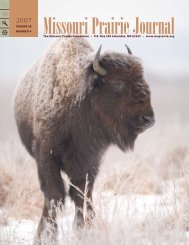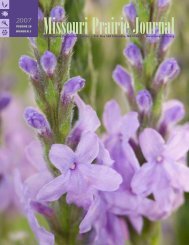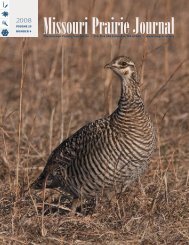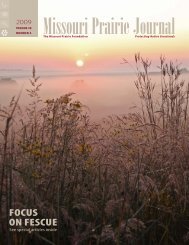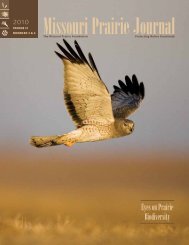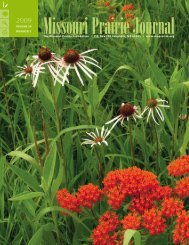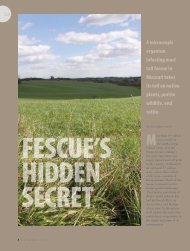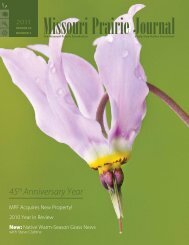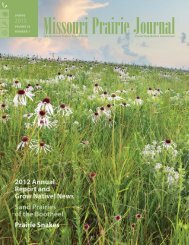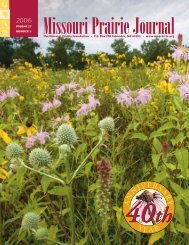Fall & Winter 2012: Volume 33, Numbers 3 & 4 - Missouri Prairie ...
Fall & Winter 2012: Volume 33, Numbers 3 & 4 - Missouri Prairie ...
Fall & Winter 2012: Volume 33, Numbers 3 & 4 - Missouri Prairie ...
You also want an ePaper? Increase the reach of your titles
YUMPU automatically turns print PDFs into web optimized ePapers that Google loves.
Max ALleger<br />
For the rest of our annual 100-bird<br />
quota, I began searching land west and<br />
north of the Air National Guard Range.<br />
Native rangeland in the Smoky Hills<br />
doesn’t get as much rain (about 25 inches<br />
annually) and burning is not as widespread<br />
or as frequent—about once every<br />
4 to 10 years. Also, cropland enrolled<br />
in the Conservation Reserve Program<br />
(CRP) was planted to a native mix of<br />
grasses and forbs or to smooth bromegrass.<br />
In average or above average rainfall<br />
years, native plantings may be too<br />
tall for chickens, but are a much more<br />
appropriate height in dry years when<br />
nearby rangeland may be grazed too<br />
short. Thus CRP may help keep Smoky<br />
Hills’ greater prairie-chicken populations<br />
from declining during dry years.<br />
While driving a Saline County road<br />
looking and listening for booming, I met<br />
Brent Laas, a local farmer and stockman,<br />
who asked me if I was lost. I said, “I<br />
know where I am, but I’m looking for<br />
folks like you who could help me find<br />
prairie-chicken booming grounds.” He<br />
said he knew of a large lek by a house he<br />
owned and I was welcome to take some<br />
of those birds if his brother, daughter,<br />
some other relatives, friends, and he<br />
could watch how the heck I intended<br />
to catch the birds. Our efforts provided<br />
several hours of entertainment for them.<br />
Satisfied we knew what we were<br />
doing, Brent said he thought there was<br />
a large lek north of I-70 in Glendale<br />
Township where he cut prairie hay. That<br />
was the beginning of a series of events<br />
that literally opened the doors to other<br />
Smoky Hills ranches. I went to Glendale<br />
Township the next morning and found a<br />
lek of <strong>33</strong> males on a wheat field, which,<br />
ironically, was owned by St. Louis attorney<br />
Maurice Springer. Further searching<br />
revealed several smaller leks. I began<br />
contacting landowners and they told me<br />
other places to look. Two landowners<br />
in particular, Gordon McClure and Hal<br />
Berkley, owned a lot of land and knew<br />
a lot of landowners. If I found a place I<br />
wanted to look, I was to tell the owners<br />
I was working with them. Further, if I<br />
needed a phone number they usually<br />
had it on their cells. One of the ranchers<br />
Gordon suggested we talk to Dick<br />
Dietrich who owned or leased thousands<br />
of acres of rangeland north of Tescott.<br />
Gordon also provided his farm headquarters<br />
for temporary storage of traps,<br />
wire, and equipment, and loaned me a<br />
fence charger to put a hotwire around<br />
leks where cattle were present.<br />
I also contacted Sandy Walker,<br />
manager of Rolling Hills Wildlife<br />
Adventures west of Salina, about a lek<br />
on her land. Sandy asked if we needed<br />
health inspections on the birds. While<br />
we didn’t have to, we did take Sandy<br />
up on her offer of the services of her<br />
resident vet, Danelle Okeson. Danelle<br />
had done Ph.D. work on Attwater’s<br />
prairie-chickens near Houston so was<br />
very familiar with prairie-chicken health.<br />
Danelle was a great trooper, even meeting<br />
me at a Salina truck stop between<br />
2:00 a.m. and 8:00 a.m. in the summer<br />
when we were transporting hens and<br />
chicks.<br />
Max ALleger<br />
Dr. Danelle Okeson, a vet from the Smoky Hills,<br />
volunteered to conduct health inspections of the<br />
birds to be translocated to <strong>Missouri</strong>. Dr. Okeson was<br />
a trooper, even meeting the crew at a truck stop at<br />
2:00 a.m. to examine trapped birds.<br />
Greater prairie-chickens fly above the wide open<br />
landscape of Kansas’ Smoky Hills Region of tall and<br />
mid-grass prairie.<br />
We provided every landowner on<br />
whose land we worked written documentation<br />
of exactly what we caught,<br />
took back, and released. We entered no<br />
land without landowners’ knowledge<br />
and we reported anything out of the<br />
ordinary, a calf out or down, broken<br />
fence wire, etc., and every gate was shut<br />
unless we found it open in which case<br />
we checked with them to make sure it<br />
was to be left open.<br />
Our trapping experience resulted<br />
in an extraordinarily good working relationship<br />
with landowners and Danelle.<br />
Over 60 landowners or their ranch<br />
managers trusted us and our word, giving<br />
us access to their land day and night.<br />
We were turned down only a handful<br />
of times and those by landowners who<br />
wanted to make sure the birds remained<br />
in good numbers where they were. Most<br />
landowners were happy that they could<br />
contribute to restoring a new population<br />
elsewhere and wanted to know how<br />
they were doing and how we planned to<br />
make sure they didn’t die out again. The<br />
latter may be our biggest challenge.<br />
Steve Clubine served as the grassland<br />
biologist for the <strong>Missouri</strong> Department of<br />
Conservation until retiring in 2010. His<br />
“Native Warm-Season Grass News”<br />
(see page 25) is a regular feature<br />
of the <strong>Missouri</strong> <strong>Prairie</strong> Journal.<br />
Vol. <strong>33</strong> Nos. 3 & 4 <strong>Missouri</strong> <strong>Prairie</strong> Journal 17




